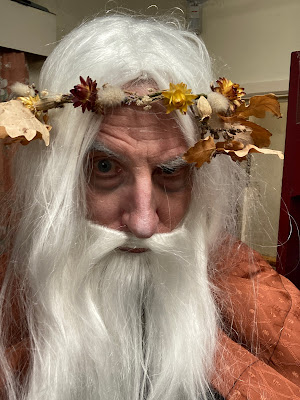 |
| Illustration by Sarah McIntyre |
I thought my Third Arthurian Phase was at end with the completion of Gwenevere, which we’ll be releasing on YouTube at Christmas… but NO! By a strange coincidence, this year’s Moorland Merrymakers panto at Leusdon Memorial Hall was Camelot. So various props and costumes from Gwenevere got another outing (a bit like how, in the early ‘80s, Adam and the Ants and Tenpole Tudor used to turn up in suits of armour from Excalibur). And I got to play Merlin…
 |
| It me. |
Obviously it wouldn’t be on for me to review a show I was in, but I thought it might be worth blogging about the script, in case anyone out there is looking for a good panto to produce. Written by Ben Crocker, Camelot comes in at a neat 2 hours 20 minutes including interval, and although at first glance the jokes are mostly fairly lame, that doesn’t seem to matter in panto - when I wrote some for the Merrymakers a few years back I think I put in too many gags, thinking they had to work like comedy. In fact, a panto script just needs to provide a good structure, and the performers can provide most of the laughs by adding in local gags and references of their own. There are about thirteen big roles in Camelot, and plenty of smaller ones for the chorus as knights, witches, and villagers. It would suit a slightly larger stage than the tiny one we have at Leusdon, and the script calls for pyrotechnic effects which were beyond us, but we seemed to get by all right without. The second half features two good, slapstick chase scenes.
The connection to actual Arthurian legend is extremely tenuous - even Guy Ritchie’s King Arthur: Legend of the Sword was more canonical than this. But this is probably how most people encountered Arthur in the past - as a vaguely familiar character popping up to slay giants in local folk tales, largely unmoored from the high-flying stuff Geoffrey of Monmouth and Thomas Malory were writing about. This Camelot is really just a standard panto plot with ‘Prince Arthur’ as principle boy, Uther Pendragon as his absent-minded father (still alive here - no sword in the stone business in this version), Guinevere as heroine, and Merlin and Morgan Le Fay in the good fairy/wicked witch roles.(Morgan is trying to stop Arthur and Guinevere marrying because ‘then Camelot will be doomed’, so there’s no Lancelot business looming in this version either, though there is a cowardly jester called Laughalot.)
The only bits of business that seem to be drawn from other Arthurian works are Arthur spying on Gwenevere as she makes her way to Camelot at the beginning, which I think comes from Lerner and Loewe’s Camelot, and Morgan le Fay imprisoning Merlin in his laboratory which I suppose echoes Nimue/Vivien imprisoning him in the cave or tree in various versions of the legend. Merlin starts to age backwards in the second half, which feels like a nod to TH White. And, slightly bizarrely, there’s a long slapstick scene involving a perilous enchanted bed, a motif which is found in Arthurian romances by Chrëtien de Troyes and others - I hope they’d be pleased to find it still entertaining us in the 21st Century.
 |
| Rob Steemson, Lloyd Mortimer, me, and Phil Smith in a scene from Camelot: the Panto |
Camelot:the Panto and Ben Crocker’s other panto scripts are available from his website.
Comments